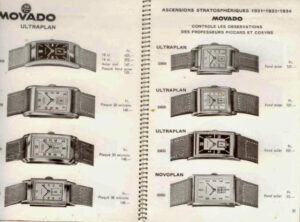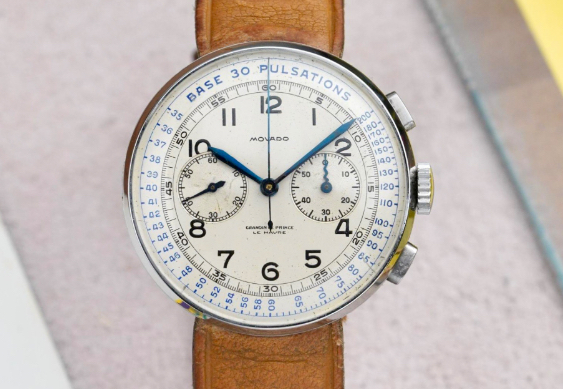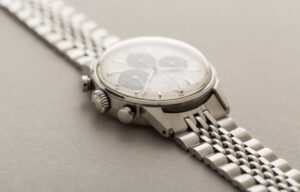
An updated 2025 resource for collectors, scholars, and horological enthusiasts
In the long history of mechanical watchmaking, certain references emerge not only as technological triumphs but as deeply aesthetic time capsules, their form and function inseparably bound. The Movado 95M chronographs, especially those housed in François Borgel (FB)-manufactured, water-resistant 35.5mm screw-back cases, belong unequivocally to this distinguished category. Though once overlooked in favor of the more famous offerings from Universal Genève, Longines, and Omega, these mid-century Movado chronographs have in recent years undergone a reappraisal—thanks to an increasingly educated collector base and a rising interest in underdog narratives of horological history.
This comprehensive editorial draws upon a library of digital archives, public and private sales records, collector documentation, and period advertising material, supplemented by personal observation and inference. The terminology used—such as “Borgel 95M” and case-style shorthand—is proprietary but intended to serve as an interpretative scaffold for further academic or collecting inquiry.
Movado Before the Quartz Curtain
Movado, founded in 1881 by Achille Ditesheim in La Chaux-de-Fonds, Switzerland, was by the mid-20th century a respected innovator, a manufacturer in control of its own destiny. Far from the licensing-heavy brand of the late 20th and early 21st century—where Movado became synonymous with fashion-oriented, quartz-driven watches sold alongside Coach and Michael Kors—its earlier output comprised genuinely important mechanical timepieces.
Movado’s portfolio from the 1930s to the early 1960s included the Calibre 90M and 95M, the aforementioned Polyplan movement (a contoured calibre designed to wrap ergonomically around the wrist), and the highly elegant Calibre 475 “Museum Watch,” later immortalized by the American designer Nathan George Horwitt. The 95M, however, is Movado’s most complex and distinct mechanical creation: a dual-register, column-wheel chronograph with an eccentric, sometimes frustrating, but ultimately ingenious thumb-lever reset system.
The 95M Movement: An Architecture of Function
The 95M (or “M95” as many now refer to it) is a manually wound chronograph movement designed and manufactured entirely in-house by Movado. It is widely believed to have first appeared in production form in the mid-to-late 1930s, with commercial rollout hitting its stride during the 1940s and 1950s.
Technically, the movement uses a column wheel and horizontal clutch layout. Rather than relying on the typical pusher-stack operation (top pusher for start/stop, bottom pusher for reset), Movado implemented a unique three-pusher system: the top pusher starts the chronograph, the bottom pusher stops it, and a thumb-lever mounted at 4 o’clock resets it. It is this third reset pusher that grants the M95 much of its mystique and identifies it at a glance to seasoned collectors. For some, it is idiosyncratic brilliance; for others, an overly complicated answer to a solved problem. But it is unmistakably Movado.
Over the course of its production life, Movado iterated on the movement in a few notable ways: the earliest calibres are signed simply “Movado,” later ones bear dual branding with Zenith (particularly during the post-1969 years when both companies were under Mondia-Zenith-Movado ownership), and some variants include calendar or even triple calendar modules.
François Borgel Cases: Sculpting Resistance
It is difficult to study the Movado 95M in isolation from its case. The finest examples—those that have attained cult status among collectors—are cased by François Borgel of Geneva, whose stamp “FB” inside a key-shaped cartouche can be found inside the screw-back case covers. Borgel, famous for his waterproofing innovations dating back to the early 20th century, was later acquired by Taubert & Fils, continuing to supply elite maisons including Patek Philippe, Vacheron Constantin, and Universal Genève.
The Movado x Borgel case partnership yielded some of the most balanced chronograph cases of the 1950s. Typically 35.5mm in diameter (measured without crown), these cases featured pump pushers, long tapering lugs, and wide bezels with steeply domed acrylic crystals. Their presence on the wrist feels both intentional and refined, with a proportion rare for the period and a waterproofing philosophy ahead of its time.
While much attention is paid to Universal Genève’s Compax line, the Movado Borgel chronos exhibit equal—if not superior—craftsmanship in execution and technical ambition. Several caseback configurations exist: some are flat-backed with deep-set serials, others exhibit slightly domed backs, and many are finely engraved with branding and Swiss import marks. Most feature thin, brushed mid-case sections and polished bevels—a now-rare combination in postwar production.
Dial Variants and Naming Conventions
The diversity of dial executions within the Borgel 95M corpus is remarkable. Based on the library compiled, the following typologies have emerged as the most commonly observed:
- “Spiral Tachy” Dials: Featuring a spiral-form tachymeter scale running from the periphery inward, often with blued leaf hands and radially arranged numerals. These are among the earliest and rarest.
- “Tele/Track” Dials: Telemetric scale on the outer ring, with an internal track-style minute register. Commonly seen in silver or cream base tones.
- “Sunburst” Dials: Typically silver sunburst finishes with blocky luminous Arabic numerals and dauphine hands—these are common on 1950s variants.
- “Tuxedo” Dials: So-named for their two-tone black and silver arrangements. Rare, but prized for dramatic contrast.
- “Post-Zenith” Dials: Labeled “Zenith-Movado,” these later examples are less collectible but offer the same mechanical heritage.
Coloration varied—eggshell white, brushed silver, champagne, anthracite gray—often dictated by the decade of production. Sub-registers range from clean, recessed circles to more heavily snailed variants. Lume types ranged from radium in early models to tritium in later ones, frequently noted by “SWISS MADE” suffixes with accompanying luminescence dots.
Hands varied as well: leaf, syringe, dauphine, and baton styles all appear depending on dial and date. It is the interplay of case, dial, and hands that gives each Borgel 95M its soul.
Comparative Study: Movado vs Universal Genève
It’s almost impossible to study the Borgel-cased Movado without drawing comparisons to Universal Genève’s Compax, Uni-Compax, and Tri-Compax chronographs. Both brands sourced cases from Borgel, both used in-house chronograph calibers, and both employed similar proportions in their mid-century references. Yet, Movado’s 95M models differ in their approach to operation and restraint.
Where Universal Genève leaned toward legibility and modernist dial aesthetics, Movado prioritized mechanical innovation and architectural case integration. UG pushers often feel more conventional; Movado’s thumb-reset makes every interaction feel bespoke. UG Compaxes have been the darlings of vintage collecting circles for longer, but the 95M offers a rarer, more esoteric pleasure. Its small production numbers, enigmatic history, and unmistakable form grant it cult appeal, especially among those already fluent in mid-century horology.
Collecting in 2025: The Digital Archive and Auction Trail
As of 2025, the Movado 95M market continues to mature, aided by greater digitization of auction results, broader online documentation, and public scholarship. Watches that could once be acquired for under $3,000 USD now regularly exceed $10,000 depending on dial rarity, condition, and provenance.
Key auction houses—Phillips, Sotheby’s, Bonhams, and Loupe This—have each featured standout examples over the past three years, some achieving near-unprecedented pricing. A rare “Spiral Tachy” model sold in early 2024 at Phillips Geneva Watch Auction for CHF 18,000, including premium. More recent listings include an anthracite dial version with sharp Borgel case edges, hammered at CHF 12,600.
Online marketplaces such as Chrono24, eBay, and CollectorsSquare also continue to shape market perception. Forums including OmegaForums, WatchProSite, and Instagram-based curators like @goldberger, @shucktheoyster, and @watchfred have been instrumental in building a crowd-sourced historical ledger.
Condition remains paramount: original pushers, unpolished case profiles, dial integrity, and crisp engraving all drastically affect value. Redialed versions are increasingly scrutinized and typically see suppressed pricing unless executed to a near-factory standard.
Impression: A Watch Worth Rediscovering
The Movado 95M in François Borgel casing is a watch that embodies a vanishing middle ground in horology—one where a respected Swiss manufacture could take genuine risks, where function and form were equally prioritized, and where collecting today still feels like discovering a secret language left behind by 20th-century engineers.
These chronographs are not just relics of a once-great manufacturer, but proof of what careful industrial design could yield at a time when mechanical chronographs still led the way in wrist-worn complexity. Whether studied academically or worn with reverence, the Borgel-cased 95M remains one of vintage horology’s best-kept, and most rewarding, secrets.
No comments yet.









